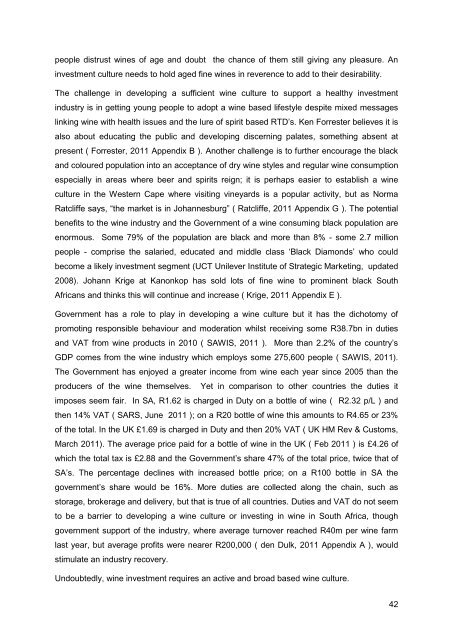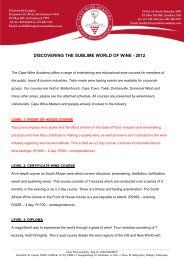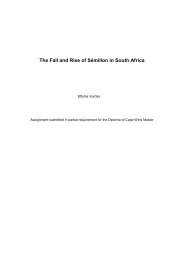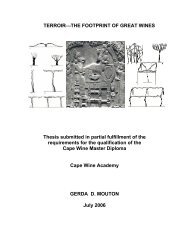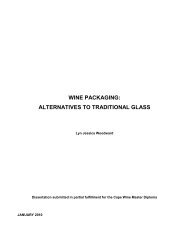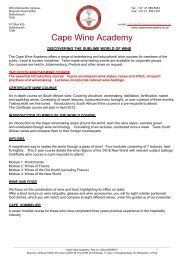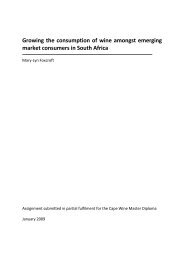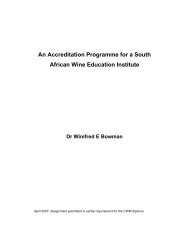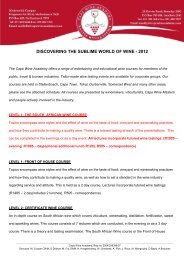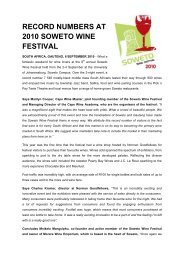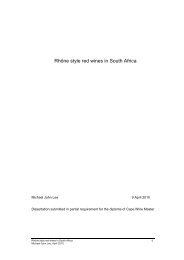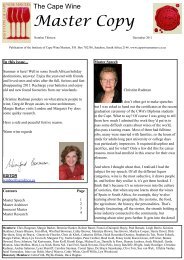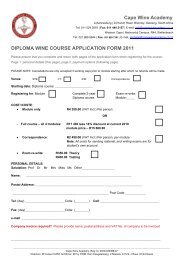Wine Investment in South Africa - Cape Wine Academy
Wine Investment in South Africa - Cape Wine Academy
Wine Investment in South Africa - Cape Wine Academy
You also want an ePaper? Increase the reach of your titles
YUMPU automatically turns print PDFs into web optimized ePapers that Google loves.
people distrust w<strong>in</strong>es of age and doubt the chance of them still giv<strong>in</strong>g any pleasure. An<br />
<strong>in</strong>vestment culture needs to hold aged f<strong>in</strong>e w<strong>in</strong>es <strong>in</strong> reverence to add to their desirability.<br />
The challenge <strong>in</strong> develop<strong>in</strong>g a sufficient w<strong>in</strong>e culture to support a healthy <strong>in</strong>vestment<br />
<strong>in</strong>dustry is <strong>in</strong> gett<strong>in</strong>g young people to adopt a w<strong>in</strong>e based lifestyle despite mixed messages<br />
l<strong>in</strong>k<strong>in</strong>g w<strong>in</strong>e with health issues and the lure of spirit based RTD’s. Ken Forrester believes it is<br />
also about educat<strong>in</strong>g the public and develop<strong>in</strong>g discern<strong>in</strong>g palates, someth<strong>in</strong>g absent at<br />
present ( Forrester, 2011 Appendix B ). Another challenge is to further encourage the black<br />
and coloured population <strong>in</strong>to an acceptance of dry w<strong>in</strong>e styles and regular w<strong>in</strong>e consumption<br />
especially <strong>in</strong> areas where beer and spirits reign; it is perhaps easier to establish a w<strong>in</strong>e<br />
culture <strong>in</strong> the Western <strong>Cape</strong> where visit<strong>in</strong>g v<strong>in</strong>eyards is a popular activity, but as Norma<br />
Ratcliffe says, “the market is <strong>in</strong> Johannesburg” ( Ratcliffe, 2011 Appendix G ). The potential<br />
benefits to the w<strong>in</strong>e <strong>in</strong>dustry and the Government of a w<strong>in</strong>e consum<strong>in</strong>g black population are<br />
enormous. Some 79% of the population are black and more than 8% - some 2.7 million<br />
people - comprise the salaried, educated and middle class ‘Black Diamonds’ who could<br />
become a likely <strong>in</strong>vestment segment (UCT Unilever Institute of Strategic Market<strong>in</strong>g, updated<br />
2008). Johann Krige at Kanonkop has sold lots of f<strong>in</strong>e w<strong>in</strong>e to prom<strong>in</strong>ent black <strong>South</strong><br />
<strong>Africa</strong>ns and th<strong>in</strong>ks this will cont<strong>in</strong>ue and <strong>in</strong>crease ( Krige, 2011 Appendix E ).<br />
Government has a role to play <strong>in</strong> develop<strong>in</strong>g a w<strong>in</strong>e culture but it has the dichotomy of<br />
promot<strong>in</strong>g responsible behaviour and moderation whilst receiv<strong>in</strong>g some R38.7bn <strong>in</strong> duties<br />
and VAT from w<strong>in</strong>e products <strong>in</strong> 2010 ( SAWIS, 2011 ). More than 2.2% of the country’s<br />
GDP comes from the w<strong>in</strong>e <strong>in</strong>dustry which employs some 275,600 people ( SAWIS, 2011).<br />
The Government has enjoyed a greater <strong>in</strong>come from w<strong>in</strong>e each year s<strong>in</strong>ce 2005 than the<br />
producers of the w<strong>in</strong>e themselves. Yet <strong>in</strong> comparison to other countries the duties it<br />
imposes seem fair. In SA, R1.62 is charged <strong>in</strong> Duty on a bottle of w<strong>in</strong>e ( R2.32 p/L ) and<br />
then 14% VAT ( SARS, June 2011 ); on a R20 bottle of w<strong>in</strong>e this amounts to R4.65 or 23%<br />
of the total. In the UK £1.69 is charged <strong>in</strong> Duty and then 20% VAT ( UK HM Rev & Customs,<br />
March 2011). The average price paid for a bottle of w<strong>in</strong>e <strong>in</strong> the UK ( Feb 2011 ) is £4.26 of<br />
which the total tax is £2.88 and the Government’s share 47% of the total price, twice that of<br />
SA’s. The percentage decl<strong>in</strong>es with <strong>in</strong>creased bottle price; on a R100 bottle <strong>in</strong> SA the<br />
government’s share would be 16%. More duties are collected along the cha<strong>in</strong>, such as<br />
storage, brokerage and delivery, but that is true of all countries. Duties and VAT do not seem<br />
to be a barrier to develop<strong>in</strong>g a w<strong>in</strong>e culture or <strong>in</strong>vest<strong>in</strong>g <strong>in</strong> w<strong>in</strong>e <strong>in</strong> <strong>South</strong> <strong>Africa</strong>, though<br />
government support of the <strong>in</strong>dustry, where average turnover reached R40m per w<strong>in</strong>e farm<br />
last year, but average profits were nearer R200,000 ( den Dulk, 2011 Appendix A ), would<br />
stimulate an <strong>in</strong>dustry recovery.<br />
Undoubtedly, w<strong>in</strong>e <strong>in</strong>vestment requires an active and broad based w<strong>in</strong>e culture.<br />
42


